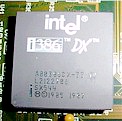 |
Hardware Specifications CPU |
 |
Hardware Specifications CPU |
|
In the case of the CPU, faster is not
always better. The speed in MHZ of the CPU is one
factor to check, but the I/O speed is another factor to
consider. If your primary applications are
CPU-intensive (lots of mathematical calculations and
graphics), then CPU speed becomes the overriding
consideration. On the other hand if your
applications are I/O-intensive (lots of disk access, web
page access, printing, etc.) then I/O speed is
important. You aren't going to see a lot of
difference between 233 MHZ and 266 MHZ, because the
increase in CPU speed is only about 13% with no increase
in I/O speed. The following table shows the
relationships:
You'll notice I don't mention the Pentium Pro chip. It's one that was obsolete almost before it came out. The only advantage of the Pentium Pro is that it is available in a quad configuration, whereas the Pentium II can only go dual. Obviously the higher speed Pentiums aren't out yet. There's always something faster and "better" around the corner, but if you keep waiting for the latest technology, you'll never get there. You're better off determining what will perform the tasks you want to perform well and starting there. Remember too that you'll pay a hefty premium to get the latest and greatest. I usually aim for something a couple of steps below the newest technology, where prices have started coming down, because there's something faster out there. Intel's strategy against the clone manufacturers such as Cyrix and AMD is to come out with new products faster than the cloners can keep up. MMX. In my opinion, MMX is more marketing hype than revolutionary technology at this point. I'd probably pick an MMX processor over non-MMX if the price was the same, but I wouldn't upgrade just to get MMX or pay much extra for MMX. While there are advantages to the MMX technology, the software has to be rewritten to take advantage of the technology. I think this will happen over time, but I don't see software manufacturers trying to push MMX-enabled programs out the door. Outside of CAD and some game programs, not many programs have been redone to take advantage of MMX. The main speed advantages touted for MMX processors, really have nothing to do with the MMX technology, it's more due to the fact that the MMX systems have more cache memory available. Chipsets. The newer Pentium motherboards require a supporting chipset to provide all of the corallary capabilities. Matching these chipsets with the corresponding CPU can be confusing. Some of these won't be available until next year. The following table shows the match:
|
Last modified: 08-29-99
accesses since
November 15, 1997
This page hosted by ![]() Get
your own Free Home Page
Get
your own Free Home Page